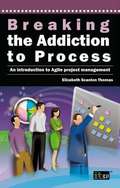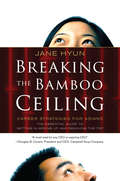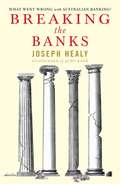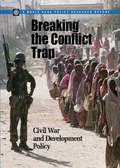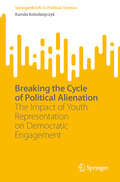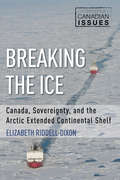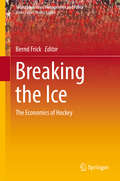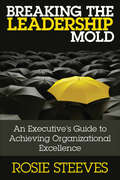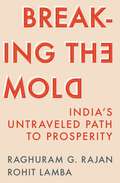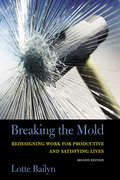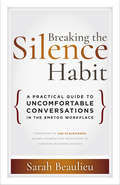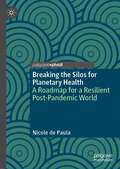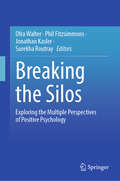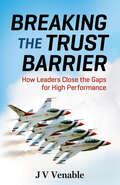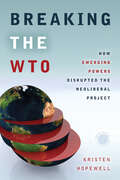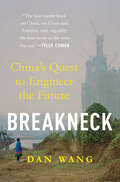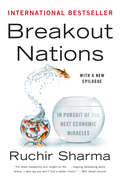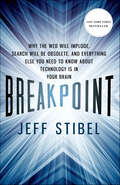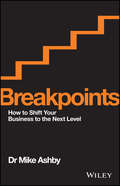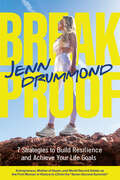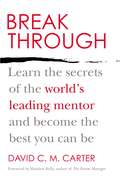- Table View
- List View
Breaking the Addiction to Process
by Elizabeth Scanlon ThomasBreaking the Addiction to Process will give you a clear understanding of the way Agile works and how it can improve your business practices. It explains how Agile will help you to improve your relationships with your customers, to work more efficiently with your colleagues and to develop more streamlined and successful working practices, saving you time and money. This practical twelve-step guide is clearly written and offers simple solutions to age-old problems. Agile is a flexible, adaptable system and this book will help you to implement it for maximum impact and success for your business. About the author Elizabeth Scanlon Thomas is a member of the Nokia Agile Community and the London Agile Community. She is a documentation manager at Nokia, having begun her career in advertising and marketing before moving into writing in IT.
Breaking the Bamboo Ceiling
by Jane HyunYou're educated and ambitious. Sure, the hours are long and corporate politics are a bane, but you focus on getting the job done, confident that you will be rewarded in the long run. Yet, somehow, your hard work isn't paying off, and you watch from the sidelines as your colleagues get promoted. Those who make it to management positions in this intensely competitive corporate environment seem to understand an unwritten code for marketing and aligning themselves politically. Furthermore, your strong work ethic and raw intelligence were sufficient when you started at the firm, but now they're expecting you to be a rainmaker who can "bring in clients" and "exert influence" on others. The top of the career ladder seems beyond your reach. Perhaps you've hit the bamboo ceiling. For the last decade, Asian Americans have been the fastest growing population in the United States. Asians comprise the largest college graduate population in America, and are often referred to as the "Model Minority" - but they continue to lag in the American workplace. If qualified Asians are entering the workforce with the right credentials, why aren't they making it to the corner offices and corporate boardrooms? Career coach Jane Hyun explains that Asians have not been able to break the "bamboo ceiling" because many are unable to effectively manage the cultural influences shaping their individual characteristics and workplace behavior-factors that are often at odds with the competencies needed to succeed at work. Traditional Asian cultural values can conflict with dominant corporate culture on many levels, resulting in a costly gap that individuals and companies need to bridge. The subtle, unconscious behavioral differences exhibited by Asian employees are often misinterpreted by their non-Asian counterparts, resulting in lost career opportunities and untapped talent. Never before has this dichotomy been so thoroughly explored, and in this insightful book, Hyun uses case studies, interviews and anecdotes to identify the issues and provide strategies for Asian Americans to succeed in corporate America. Managers will learn how to support the Asian members of their teams to realize their full potential and to maintain their competitive edge in today's multicultural workplace.
Breaking the Banks: What went wrong with Australian banking?
by Joseph HealyWhat was once an industry built on trust, professionalism and value, has become synonymous with greed, complacency and everything that has gone wrong with capitalism. So how did Australian banks, which avoided much of the aftermath of the GFC, lose their way and become engulfed in scandal?Breaking the Banks delves into the causes and effects of the banking crisis that plagued Australia and the world, to re-establish the fundamentals of banking that for so long have been overshadowed by power and wealth, and provides us with a crucial blueprint to revolutionise the future of banking. With expertise in banking that spans over three decades and several markets and as a former senior executive at two of Australia&’s largest banks, Joseph Healy, co-founder and co-CEO of Judo Bank, writes the insider&’s account of the banking crisis that plagued Australia and the world.
Breaking the Buck
by Robert C. Pozen Elizabeth M. LeonardCase - After an incredibly volatile six months since Lehman Brothers declared bankruptcy, Finbar McCall contemplated his options. As the investment manager of RPG Prime Reserve Fund, Inc. (RPGXX), McCall had just heard the news that the U.S. Treasury was extending the availability of insurance for eligible money market funds. When the insurance was first offered in September of 2008, RPGXX immediately applied for coverage. McCall's dilemma in February of 2009, when an extension of the Treasury insurance was offered, involved weighing the cost of the insurance against the comfort it might provide to skittish RPGXX shareholders and the increased flexibility it would allow in investing RPGXX's assets. This case provides a brief history and explanation of money market funds, the phenomenon known as "breaking the buck," and how the government's assistance changed the landscape of money market funds in the last months of 2008 and into 2009.
Breaking the Conflict Trap: Civil War and Development Policy
by World BankCivil war conflict is a core development issue. The existence of civil war can dramatically slow a country's development process, especially in low-income countries which are more vulnerable to civil war conflict. Conversely, development can impede civil war. When development succeeds, countries become safer--when development fails, they experience a greater risk of being caught in a conflict trap. Ultimately, civil war is a failure of development. 'Breaking the Conflict Trap' identifies the dire consequences that civil war has on the development process and offers three main findings. First, civil war has adverse ripple effects that are often not taken into account by those who determine whether wars start or end. Second, some countries are more likely than others to experience civil war conflict and thus, the risks of civil war differ considerably according to a country's characteristics including its economic stability. Finally, Breaking the Conflict Trap explores viable international measures that can be taken to reduce the global incidence of civil war and proposes a practical agenda for action. This book should serve as a wake up call to anyone in the international community who still thinks that development and conflict are distinct issues.
Breaking the Cycle of Political Alienation: The Impact of Youth Representation on Democratic Engagement (SpringerBriefs in Political Science)
by Kamila KolodziejczykThis book explores the underrepresentation of youth in political institutions and its impact on young people’s connection to democracy. The underrepresentation of youth in politics fuels a vicious cycle of political alienation. Due to the low presence of youth in political institutions, their specific interests are not adequately represented and therefore policies important to youth are not implemented, which leaves youth with feelings of apathy and disconnect to the formal political systems. Through an original dataset spanning 52 democratic countries and over two decades, this book examines whether increasing youth representation in parliaments and government can disrupt this cycle of alienation and encourage higher electoral participation and greater satisfaction with democracy among young people. The findings suggest that while the effects may be moderate, increased youth representation can positively influence young people's political engagement and increase democratic satisfaction. This book offers insights for policymakers and advocates seeking to bridge the generational divide in political participation and is also an important contribution to the literature on youth political representation.
Breaking the Ice: Canada, Sovereignty, and the Arctic Extended Continental Shelf (Contemporary Canadian Issues)
by John English Elizabeth Riddell-DixonThe Hill Times: Best Books of 2017. The Arctic seabed, with its vast quantities of undiscovered resources, is the twenty-first century’s frontier. In Breaking the Ice: Canada, Sovereignty and the Arctic Extended Continental Shelf, Arctic policy expert Elizabeth Riddell-Dixon examines the political, legal, and scientific aspects of Canada’s efforts to delineate its Arctic extended continental shelf. The quality and quantity of the data collected and analyzed by the scientists and legal experts preparing Canada’s Arctic Submission for the Commission on the Limits of the Continental Shelf, and the extensive collaboration with Canada’s Arctic neighbours is a good news story in Canadian foreign policy. As Arctic sovereignty continues to be a key concern for Canada and as the international legal regime is being observed by all five Arctic coastal states, it is crucial to continue to advance our understanding of the complex issues around this expanding area of national interest.
Breaking the Ice: The Economics of Hockey (Sports Economics, Management and Policy #16)
by Bernd FrickThis book provides a survey of the academic research and knowledge on the economics and management of professional hockey. While professional football, baseball, and basketball have been the focus of sports economists for decades, professional hockey has been left out of most economic analyses of the sports industry. This book fills that gap by presenting a selection of research focusing specifically on hockey, such as labor relations and player behavior in the NHL, salary determination and player careers, ticket demand and ticket pricing, and emerging topics such as diversity and discrimination. Expanding the available literature dramatically, this book will be an important tool for researchers as well as sports managers, and students at the advanced undergraduate and graduate level.
Breaking the Impediments to Budgetary Reforms: Evidence from Europe
by Stefania Fabrizio Ashoka ModyA report from the International Monetary Fund.
Breaking the Leadership Mold: An Executive's Guide to Achieving Organizational Excellence
by Rosie SteevesMuch has been written about leaders and leadership. Journal articles, blogs and books try to home in on the essence of an effective leader. While there is common agreement that a executive's performance can make or break company, defining that essence of effective leadership remains the Holy Grail for those who find themselves at the top, for those who are responsible for carrying out the strategies and dictates of their managers, and for the shareholders who want to see commitment, action and positive financial return. Breaking the Leadership Mold is designed to help senior executives and managers respond to the challenges of today and shed the vestiges of days gone by. In so doing they will better lead and enable their staff, and create a work environment that is healthy, engaging, productive and sustainable. Based on the author's extensive research and 35 years' experience in working with local, national and international companies, Breaking the Leadership Mold offers 20 principles-such as Principle #10: Recognize How Executive Team Dynamics Promote Mediocrity and Principle #14: Get Other Executives On Board (or Out of the Way)--that when implemented will ensure that not only is there effective communication throughout the organization, from top to bottom and bottom to top, but also that employees and executives alike contribute to their full potential. The net result -- the organization wins on every measure. The 20 principles are built on the pillars of case studies, experience and research. Effective leadership is an absolute in any business environment, but becomes even more critical in times when businesses face unprecedented challenges and need to be nimble and responsive to change. Breaking the Mold has proven strategies to empower, unite and galvanize managers and employees -- and their organization - to enable them to prosper and adapt in a swift-changing environment.
Breaking the Mold: India’s Untraveled Path to Prosperity
by Raghuram G. Rajan Rohit LambaThe new path for economic development that India must create The whole world has a stake in India&’s future, and that future hinges on whether India can develop its economy and deliver for its population—now the world&’s largest—while staying democratic. India&’s economy has overtaken the United Kingdom&’s to become the fifth-largest in the world, but it is still only one-fifth the size of China&’s, and India&’s economic growth is too slow to provide jobs for millions of its ambitious youth. Blocking India&’s current path are intense global competition in low-skilled manufacturing, increasing protectionism and automation, and the country&’s majoritarian streak in politics. In Breaking the Mold, Raghuram Rajan and Rohit Lamba show why and how India needs to blaze a new path if it&’s to succeed.India diverged long ago from the standard development model, the one followed by China—from agriculture to low-skilled manufacturing, then high-skilled manufacturing and, finally, services—by leapfrogging intermediate steps. India must not turn back now. Rajan and Lamba explain how India can accelerate growth by prioritizing human capital, expanding opportunities in high-skilled services, encouraging entrepreneurship, and strengthening rather than weakening its democratic traditions. It can chart a path based on ideas and creativity even at its early stage of development.Filled with vivid examples and written with incisive candor, Breaking the Mold shows how India can break free of the stumbling blocks of the past and embrace the enormous possibilities of the future.
Breaking the Mold: Redesigning Work for Productive and Satisfying Lives
by Lotte BailynIn Breaking the Mold, Lotte Bailyn argues that society's separation of work and family is no longer a tenable model for employees or the organizations that employ them. Unless American business is willing to radically rethink some of its basic assumptions about work, career paths, and time, both employee and employer will suffer in today's intensely competitive business environment. Bailyn's message was bold when this book was originally published in 1993. Now thoroughly updated to reflect the latest developments in the organization of work, the demography of the workforce, and attitudes toward the integration of work and personal life, this second edition is even more compelling. Bailyn finds that implementation of policies designed to allow "flexibility" is rarely smooth and often results in gender inequity. Using real-life cases to illustrate the problems employees encounter in coordinating work and private life, she details how corporations generally handle these problems and suggests models for innovation. Throughout, she shows how the structure and culture of corporate life could be changed to integrate employees' other obligations and interests, and in the process help organizations become more effective. Drawing on international comparisons as well as many years of working with organizations of various kinds, Bailyn emphasizes the need to redesign work itself. Breaking the Mold allows us to rethink the connections between organizational processes and personal concerns. Implementation of Bailyn's suggestions could help employees to become more effective in all realms of their complicated lives and allow employing organizations to engage their full productive potential.
Breaking the Ring
by John BarronThe bizarre case of the espionage operation of the John Walker family and the U.S. government's hunt for the spy and his accomplices.
Breaking the Silence Habit: A Practical Guide to Uncomfortable Conversations in the #MeToo Workplace
by Sarah BeaulieuTop consultant Sarah Beaulieu offers a five-part framework that enables employees to have difficult but necessary conversations about sexual harassment and violence and develop new, better ways of working together. In the wake of the #MeToo movement, employees and leaders are struggling with how to respond to the pervasiveness of sexual harassment. Most approaches simply emphasize knowing and complying with existing laws. But people need more than lists of dos and don'ts—they need to learn how to navigate this uncertain, emotionally charged terrain. Sarah Beaulieu provides a new skills-based approach to addressing sexual harassment prevention and response in the workplace, including using underdeveloped skills like empathy, situational awareness, boundary setting, and intervention.Beaulieu outlines a five-part framework for having conversations about sexual harassment: Know the Facts; Feel Uncomfortable; Get Curious, Not Furious; See the Whole Picture; and Embrace Practical Questions. By embracing these conversations, we can break the cycle of avoidance and silence that makes our lives and workplaces feel volatile and unsafe. Grounded in storytelling, humor, and dozens of real-life scenarios, this book introduces the idea of uncomfortable conversation as the core skill required to enable everyone to bring their full talent and contributions to safe and respectful workplaces.
Breaking the Silos for Planetary Health: A Roadmap for a Resilient Post-Pandemic World
by Nicole de PaulaThis book translates the latest theoretical perspectives on the emerging field of Planetary Health Studies into the practical reality of global political decision makers. It builds on the scientific data on the impacts of environmental change on human health to propose practical methods for operationalizing planetary health. The book maps opportunities for decision makers to break institutional silos and engage with bottom-up approaches that can transform planetary health from a global idea into a local reality. The analysis frames human health in the Anthropocene, an era in which humans have become the most powerful force affecting global ecosystems, and reveals new existential risks for humankind.Departing from ongoing multilateral efforts to promote sustainability, the author’s analysis places the agenda of planetary health on the desk of political decision makers, still underrepresented at planetary health gatherings. Given the pressing need to implement sustainable development policies, the book presents planetary health as an overarching framework for global policy targets, notably the UN Sustainable Development Goals, the Paris Agreement on Climate Change, and the post-2020 biodiversity framework under the UN Convention on Biological Diversity. The book is timely in offering a concrete road map for practitioners and researchers interested in transforming the concept of planetary health into reality. With a collection of success stories, the analysis dwells on tools for community engagement, opportunities for health professionals training, gender empowerment, digital health, and innovative ways to enhance human well-being on a changing planet.
Breaking the Silos: Exploring the Multiple Perspectives of Positive Psychology
by Surekha Routray Ofra Walter Phil Fitzsimmons Jonathan KaslerThis book offers a new look at well-being from a multidisciplinary standpoint. Research from industry clearly indicates that factors such as creativity, critical awareness, well-being, interdisciplinary understanding of positive psychology, and the ability to form strong relationships will determine the viability of organizations as collectively we enter the second half of the twenty-first century. Thus, a sound understanding of how these facets become melded into entrepreneurship, the workplace environment, and creative innovation is a requirement for individuals in the workplace. With a dearth of information about these facets as individual components and as a collective whole, this book draws these elements of overall well-being into a multidisciplinary focus. Thus, with chapters covering diverse fields such as philosophy, education, economics, mathematics, and medicine, the book offers a fresh approach to how positive psychology impacts entrepreneurship.
Breaking the Trust Barrier: How Leaders Close the Gaps for High Performance
by JV VenableBuild Extraordinary Trust and Lead Your Team to a Higher Plane For former US Air Force Thunderbirds' commander and demonstration leader JV Venable, inspiring teamwork was literally a matter of life and death. On maneuvers like the one pictured on the cover, the distance between jets was just eighteen inches. Closing the gaps to sustain that kind of separation requires the highest levels of trust.On the ground or in the air, from line supervisor to CEO, we all face the same challenge. Our job is to entice those we lead to close the gaps that slow the whole team down—gaps in commitment, loyalty, and trust. Every bit of closure requires your people to let go of biases and mental safeguards that hold them back. The process the Thunderbirds use to break that barrier and craft the highest levels of trust on a team with an annual turnover of 50 percent is nothing short of phenomenal. That process is packaged here with tips and compelling stories that will help you build the team of a lifetime.
Breaking the WTO: How Emerging Powers Disrupted the Neoliberal Project
by Kristen HopewellThe world economic order has been upended by the rise of the BRIC nations and the attendant decline of the United States' international influence. In Breaking the WTO, Kristen Hopewell provides a groundbreaking analysis of how these power shifts have played out in one of the most important theaters of global governance: the World Trade Organization. Hopewell argues that the collapse of the Doha Round negotiations in 2008 signals a crisis in the American-led project of neoliberal globalization. Historically, the U.S. has pressured other countries to open their markets while maintaining its own protectionist policies. Over the course of the Doha negotiations, however, China, India, and Brazil challenged America's hypocrisy. They did so not because they rejected the multilateral trading system, but because they embraced neoliberal rhetoric and sought to lay claim to its benefits. By demanding that all members of the WTO live up to the principles of "free trade," these developing states caused the negotiations to collapse under their own contradictions. Breaking the WTO probes the tensions between the WTO's liberal principles and the underlying reality of power politics, exploring what the Doha conflict tells us about the current and coming balance of power in the global economy.
Breaking the Wire: The Future of Telecommunications
by Clayton M. Christensen Scott D. Anthony Erik A. RothThis chapter focuses on the telecommunications industry as a microcosm of the dynamics of disruptive change. The chapter evaluates four specific developments--voice-over internet protocol, cable telephony, wireless data, and activities in fringe markets, such as instant messaging--and examines what broad implications each may have for the industry.
Breakneck: China's Quest to Engineer the Future
by Dan WangLonglisted for the Financial Times and Schroders Business Book of the Year Award <p> An August 2025 Next Big Idea Club Must-Read Book <p> A riveting, firsthand investigation of China’s seismic progress, its human costs, and what it means for America. <p> For close to a decade, technology analyst Dan Wang—"a gifted observer of contemporary China" (Ross Douthat)—has been living through the country’s astonishing, messy progress. China’s towering bridges, gleaming railways, and sprawling factories have improved economic outcomes in record time. But rapid change has also sent ripples of pain throughout the society. This reality—political repression and astonishing growth—is not a paradox, but rather a feature of China’s engineering mindset. <p> In Breakneck, Wang blends political, economic, and philosophical analysis with reportage to reveal a provocative new framework for understanding China—one that helps us see America more clearly, too. While China is an engineering state, relentlessly pursuing megaprojects, the United States has stalled. America has transformed into a lawyerly society, reflexively blocking everything, good and bad Blending razor-sharp analysis with immersive storytelling, Wang offers a gripping portrait of a nation in flux. Breakneck traverses metropolises like Shanghai, Chongqing, and Shenzhen, where the engineering state has created not only dazzling infrastructure but also a sense of optimism. The book also exposes the downsides of social engineering, including the surveillance of ethnic minorities, political suppression, and the traumas of the one-child policy and zero-Covid. <p> In an era of animosity and mistrust, Wang unmasks the shocking similarities between the United States and China. Breakneck reveals how each country points toward a better path for the other: Chinese citizens would be better off if their government could learn to value individual liberties, while Americans would be better off if their government could learn to embrace engineering—and to produce better outcomes for the many, not just the few. <p> <b>New York Times Bestseller</b>
Breakout Nations: In Pursuit of the Next Economic Miracles
by Ruchir SharmaInternational Bestseller One of Foreign Policy's "21 Books to Read in 2012" A Publishers Weekly Top 10 Business Book "The best book on global economic trends I've read in a while."--Fareed Zakaria, CNN GPS To identify the economic stars of the future we should abandon the habit of extrapolating from the recent past and lumping wildly diverse countries together. We need to remember that sustained economic success is a rare phenomenon. After years of rapid growth, the most celebrated emerging markets--Brazil, Russia, India, and China--are about to slow down. Which countries will rise to challenge them? In his best-selling book, writer and investor Ruchir Sharma identifies which countries are most likely to leap ahead and why, drawing insights from time spent on the ground and detailed demographic, political, and economic analysis. With a new chapter on America's future economic prospects, Breakout Nations offers a captivating picture of the shifting balance of global economic power among emerging nations and the West.
Breakpoint
by Jeff StibelWhat can the human brain and its relationship to the internet tell us about our society, our technologies, and our businesses? A lot, as it turns out. The internet today is a virtual replica of the brain, and the networks that leverage it grow and collapse in ways that are easily predictable if you understand the brain and other biological networks. We're living in the midst of a networking revolution. All of the major technology innovations of the 21st century – social networking, cloud computing, search engines, and crowdsourcing, to name a few – leverage the internet and are thus bound by the rules of networks. We've seen the exponential growth of these technologies, and they've led to a more efficient and tightly connected world. But what many people don't realize is that all networks eventually reach a breakpoint and collapse. This happens in the brain, it happens in nature, it happened to MySpace, and it will happen to Facebook and Google. It is critical to understand where the breakpoint is in the networks you use in order to achieve optimum success. Navigating the world of new technologies today can be like walking through a minefield unless you know the path. Imagine what you could do with a roadmap for where things are headed? In this fascinating look at the future of business and technology, neuroscientist and entrepreneur Jeff Stibel shows how the brain can act as a guide to understanding the future of the internet and the constellation of businesses and technologies that run on it. He'll show how leaders like Marissa Mayer are using artificial intelligence to literally remake Yahoo! and how startups like oDesk and Kickstarter are using crowdsourcing, the next wave of revolutionary technology, to create something much larger and "smarter" than the sum of their parts. Stibel offers a fresh perspective about the future of business and technology in a candid and engaging manner.
Breakpoints
by Mike AshbyFind your drive and redefine your business priorities Breakpoints is the business owner's guide to regaining your passion and driving your business forward. If you're feeling stuck, stale or stalled, this book is your ticket out of the rut and into profitable growth. You'll learn the 7 Mistakes Business Owners Make, and identify the choices, behaviours and practices that are keeping your business in a holding pattern. Practical formulas, frameworks, strategies and tools get you started right away on refocusing and reprioritising, and taking back your life. Coverage includes both hard and soft topics that business owners frequently struggle to master, along with expert insight on execution and what lies beyond success. Written simply and directly, without jargon or acronyms, this no-nonsense guide is designed to be easy to read and easy to apply so you can get back to work quickly, inspired with a whole new outlook and equipped with practical tools to improve your business. Written in a style that is both conversational and entertaining, author Dr Mike Ashby offers numerous anecdotes and analogies drawn from working with hundreds of business owners. Owning a business can be exciting and terrifying at the same time. There's too much to do, and all accountability leads to you. If you've gotten hung up in the day-to-day running of your business, this book helps you regain sight of the big picture and get back on track to success. Learn what's holding you back from business success Adopt the tools and practices that end the stalemate and get things done Find clarity and focus, and reconnect with your business Leverage your strengths to achieve personal and business growth Business owners need to be well-versed in both strategy and execution. If you feel like you and your business have reached a plateau, Breakpoints will reignite the spark that drives business success.
Breakproof: 7 Strategies to Build Resilience and Achieve Your Life Goals
by Jenn DrummondDiscover Resilience and Reach Your Life Goals#1 New Release in Popular Applied Psychology BreakProof is a gripping testament to never giving up. The book embodies the spirit of a true go-getter and highlights the importance of life balance, goal setting, and living life to the fullest.Discover resilience in adversity.BreakProof chronicles Jenn Drummond’s pursuit to conquer the Seven Second Summits, despite no mountain climbing experience. Through this emotional and physical journey toward that audacious goal, the world record-holding mountaineer provides lessons on never giving up, cultivating resilience, and finding strength in the face of life's greatest challenges. Embark on a journey of personal growth. Mountain climbers consider the second-highest mountains on all seven continents to be technically more complex than the seven highest. Jenn's experiences on the mountains serve as metaphors for achieving life goals and inspiring continuous self-improvement. In BreakProof, she shares her struggles and victories and delivers potent insights into achieving balance, setting meaningful objectives, and living life to its fullest. The 7 secrets to realizing your life dream. In June 2023, Jenn became the first woman in the world to conquer the Seven Second Summits. Life goal reached! Learn the 7 secrets to how Jenn did it and how you can apply her hard-earned lessons to learning how never to quit.Inside, discoverActionable strategies and exercises to take the first steps, build resilience, and handle life's challengesThe importance of goal setting and continuous self-improvement and personal growthWays to troubleshoot seemingly insurmountable obstaclesInspiration for becoming a go-getter, never giving up, embracing life balance, and living life to the fullestIf you have read books such as This Year I Will…, Mindful Self-Discipline, or the mega-bestseller, The 7 Habits of Highly Effective People, then BreakProof is a must-read.
Breakthrough
by David C. M. CarterChoose to be the best version of yourself-and keep on choosing it! For the first time, the world's leading mentor David C. M. Carter shares his most effective "breakthrough" secrets in this practical guide to becoming the best you can be. Previously only accessible to his handful of exclusive international clients, these strategies are the key to a more successful and happier you. By following them, you will learn how to identify and clarify your goals-and then achieve them in every area of your life. With simple easy-to-action "breakthroughs" outlined in each chapter, complete with how-to tools, you'll have no excuse to live anything less than the life you were destined to live. .
